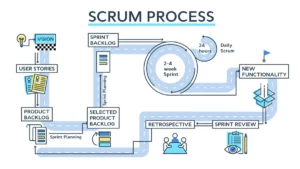What is an AINO?
When a company is Agile in Name Only, it means that they are going through the motions of Agile methodologies such as SCRUM or SPRINTs, but are not fully embracing the principles and values that underlie the Agile approach.
Agile methodologies can fail for several reasons. Here are some common ones:
- Lack of commitment: Agile methodologies require commitment and involvement from everyone on the team, as well as support from the organization. If there is a lack of commitment or buy-in, Agile can fail.
- Inadequate training and coaching: Agile methodologies require a different way of working than traditional project management approaches. If the team lacks the knowledge, skills, and coaching necessary to effectively use Agile methodologies, it can lead to failure.
- Poorly defined processes and practices: Agile methodologies are based on specific processes and practices that need to be well-defined and understood by the team. If these processes and practices are poorly defined or not understood, it can lead to confusion and failure.
- Ineffective communication: Effective communication is essential in Agile methodologies. If team members are not communicating effectively or if there is a lack of collaboration, it can lead to misunderstandings and mistakes.
- Resistance to change: Agile methodologies require a shift in mindset and culture. If there is resistance to change within the team or the organization, it can lead to failure.
- Insufficient planning and preparation: Although Agile methodologies emphasize adaptability and flexibility, there is still a need for planning and preparation. If there is insufficient planning and preparation, it can lead to a lack of direction and focus.
To avoid these pitfalls, it’s important to ensure that everyone involved understands the Agile principles and values, provide adequate training and coaching, clearly define processes and practices, promote effective communication and collaboration, and ensure there is sufficient planning and preparation. It’s also important to address any resistance to change and ensure that everyone is committed to making Agile work.
Critical Agile Roles
There are several critical roles for success in an Agile environment. These roles are designed to facilitate collaboration, communication, and productivity within the team. Here are some of the key roles:
- Product Owner: The Product Owner is responsible for defining and prioritizing the product backlog. They work closely with the team to ensure that the product meets the needs of the customer or user.
- Scrum Master: The Scrum Master is responsible for facilitating the Scrum process and ensuring that the team adheres to Agile principles and practices. They also help to remove obstacles and ensure that the team is working efficiently.
- Development Team: The Development Team is responsible for building the product. They work closely with the Product Owner to understand the requirements and with the Scrum Master to ensure that the process runs smoothly.
- Stakeholders: Stakeholders are anyone who has an interest in the product, such as customers, users, sponsors, or executives. They provide feedback and guidance to the team and help to ensure that the product meets their needs.
- Agile Coach: An Agile Coach is an expert in Agile methodologies and provides guidance and training to the team. They help the team to adopt Agile principles and practices and ensure that the team is continuously improving.
- Technical Lead: The Technical Lead is responsible for ensuring that the technical aspects of the project are sound. They work with the Development Team to ensure that the code is well-designed, maintainable, and scalable.
- UX Designer: The UX Designer is responsible for ensuring that the user experience is intuitive, engaging, and meets the needs of the user. They work closely with the Product Owner and the Development Team to ensure that the product is designed with the user in mind.
Overall, adopting Agile methodologies can help companies to be more responsive, adaptable, and customer-focused, and can ultimately lead to better outcomes for both the company and its customers. These roles are critical for success in an Agile environment. Each role has a specific responsibility and helps to ensure that the team is working collaboratively and efficiently to build a product that meets the needs of the customer or user.
Discover more from AJB Blog
Subscribe to get the latest posts sent to your email.







